Korean Sushi. Where the Wild Things Are. Wassada Sushi Sashimi. Koreatown, LA.
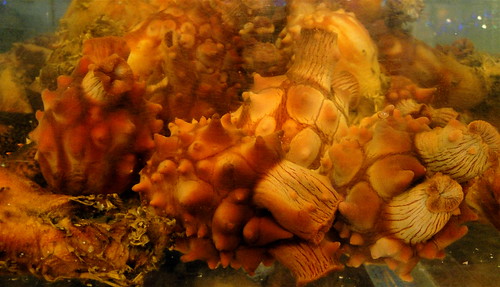
The guy who ate the first seasquirt was probably more than a little hungry.
You know Korean barbeque — that fantastically flavorful grilled meat of various animal flesh like beef, pork and chicken. One day it will be as ubiquitous as American barbeque is in the U.S.
And you know what a Korean taco is. Some of that same tasty grilled meat snuggled into a corn tortilla and, for all intents and purposes, created by the Kogi BBQ empire.
How about Korean fried chicken? Double fried and delicate. Sweet and garlicky or seasoned in a hot pepper sauce. Korean fried chicken, the better KFC!
And, check it, homeskool, you best know what Korean breakdancing is all about. Respect!
NoKo is calling you out, yo!
But do you know Korean sushi? What is it exactly and how is it different from Japanese sushi? Yes, it is basically a variation of the Japanese concept, but it’s also much more.
For starters, wasabi is not quite the indispensable condiment as it is with its Japanese counterpart. Cho jang, a vinegar and soy sauce based dipping sauce, is the slathering of choice. But don’t worry, wasabi is always nearby on standby but not necessarily used.
Some other odd yet fascinating points of cultural preference are the texture and size of the raw cuts of fish. Korean sushi and sashimi restaurants mostly serve them in bigger portions (roughly twice the size of a tradition-bound Japanese joint). Japanese sushi houses believe strongly that sushi or sashimi should be eaten in one comfortable bite. With Korean sashimi, size does matter. The bigger, the better.
Further, Korean sashimi, i.e. an unadorned cut of raw fish, has a vaguely frozen or nearly thawed texture, slightly icy and chewy. It’s weirdly satisfying like a frozen Snickers Bar or Twinkie is.
Aside from those, perhaps, minor observations, the big differences are with the types of seafood offered.
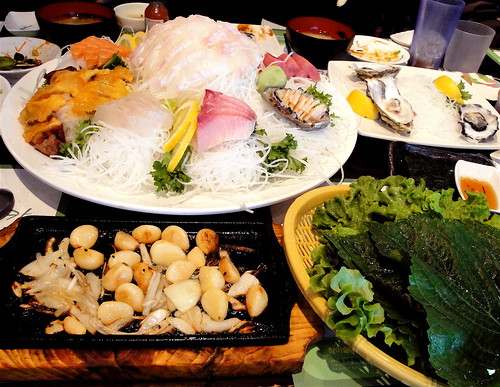
Super sushi size me!
The Japanese places serve mainly fresh fish, offering the standard roster of tuna, salmon, hamachi and so on, usually handpicked really early in the morning at a massive fish market. The occasional odd ocean edible is also offered. Depending on where you go, it could be uni, eel, shirako, fugu or Sei whale. Not many of the Japanese places in the U.S. are rigged with fish tanks so live or freshly dispatched fish is not commonplace.
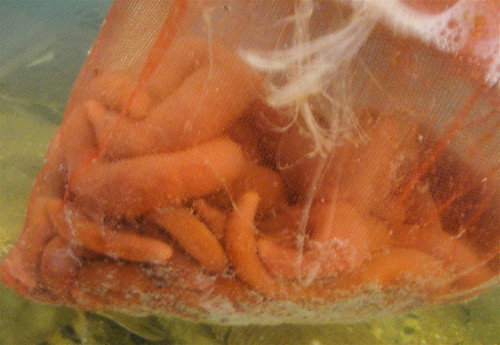
Mmmm, sea worm sack.
However, one of the first things you’ll notice when entering a Korean sushi place are the fish tanks filled with a bountiful buffet of sea creatures. Wassada Sushi Sashimi located in Koreatown’s Western corridor is no exception.
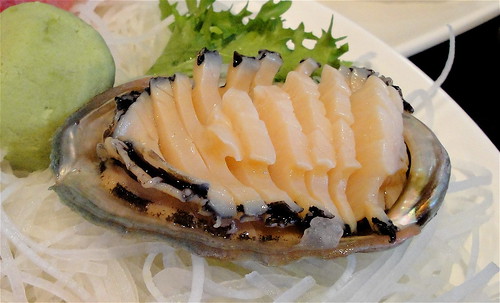
Ah, baloney!
At Wassada, they can and will sashimi everything, from the lopsided, flat flounder to the strange sea squirt and the crunchy abalone to the lowly yet tasty gaebul or sea worm.

The fresh and the furious.
Anything originating from the tanks is not only served extremely fresh but most likely alive as well. Depending on what it is that has been ordered, the sea creature may be more animated than most. Our plate of gaebul wriggled about like worms normally do except they’ve been slit open and cleaned out of innards. However, the legendary sannakji aka live octopus tentacles outwriggled and outwrithed the gaebul by a longshot. The octopus tentacles are fiercer and higher up on the foodchain from the sea worms even when disembodied.

Sea worm & sea cucumber. One isn't really a vegetable.
The gaebul has a firmer texture and doesn’t put up much of a fight. On the other hand, the sannakji is out for revenge and might just get it if you down one soju shot too many, get sloppy and don't chew your raging tentacles well enough to keep them from strangling you from within. Both,however, take on nicely the sesame oil dipping sauces that accompany them.

Sannakji — not your father's sashimi.
Kinetic cuisine may not be your thing, but that’s okay because with Korean sushi there’s something for everyone. If you’re into kinky textures, then a friendly albeit English-challenged Wassada employee will reach into the tank of oceanic treats and pull out some of the slimiest and, somewhat phallic, soon-to-be-sashimi organisms you’ll ever experience.
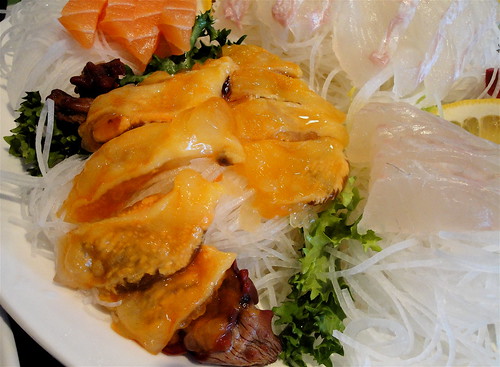
I've been slimed by seasquirt!
The one-two punch of live sea cucumber and sea squirt would put even Andrew Zimmern into a fetal position with thumb firmly inserted into mouth. The sea cucumber is slick and thick with mucus and much squishier than in its usually braised state. But, man, oh, man, the aptly named sea squirt (yes, it squirts when it’s whole and alive) is slimier, squishier and more akin to something that was once solid but has now decomposed into neon-orange sludge. I thoroughly enjoyed them both.
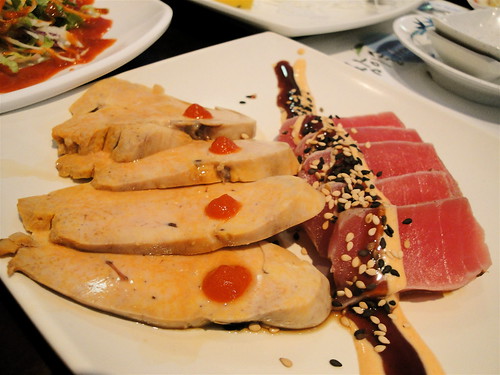
Monkfish liver. Overfished but, oh, so good.
The luxurious ingots of monkfish liver dolloped with red chili sauce were nothing less than erotic — velvety with subtle sea flavors and like butt-ah. This "foie gras of the sea" was presented in the aforementioned Korean-style of large portion sizes with several servings on the platter. (There is such a thing as a multiple orgasm.) Thank God, Wassada isn’t a family restaurant, so moan away with pleasure.

Rolly polly fish head.
If you happen to be a disciple of the head to tail eating movement, you won’t be disappointed because next to your fried mackerel and baked clam casserole is a large fried head of a salmon. The finest part of the salmon head, its eyeball, is simply superb, perfectly cooked so that the eye socket’s flesh clings to the eyeball as its plucked out of its hole. It’s see-food like no other.

Sea snail snacks. Say that five times fast.
And, of course, Korean food wouldn’t be Korean food without freebie sides. Since this is, in actuality, Japanese food remixed by Koreans, the term for these small plates should probably be tsuki-dashi rather than banchan. Whatever you want to name them, they’re simply tasty. A smattering of edamame, grilled garlic cloves, rice porridge with sesame seeds, sea snails, among other diminutive delights launches this feast of fish.
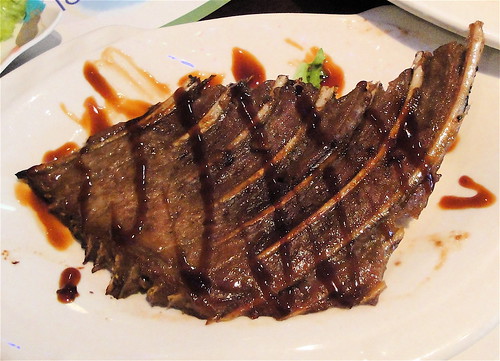
Fish ribs. Rack 'em!
One of my favorite small plates was the teriyaki salmon ribs. Yes, you read that right. Fish ribs. Nothing but nothing is dumpster destined when we’re talking Korean sushi. And there is nothing quite like Korean sushi — a little traditional and a little over-the-top.
If traditional Japanese sushi or sashimi is like classical music with its adherence to strict guidelines and conventions, Korean style sushi and sashimi might be comparable to the bombastic works of Richard Wagner. As with Wagner’s The Ride of the Valkyries, it’s big, histrionic, amusing, frightening, and, yeah, delicious.
So when you find yourself suffering from sushi-fatigue now and again, check out a Korean sushi spot. The experience is like a gastronomic tweak to the nipples. Just don’t expect your waitstaff to show up wearing horned helmets and hurling lightning bolts.
Wassada Sushi Sashimi
377 N. Western Ave.
Los Angeles, CA 90004
323.464.9010
Ride on!
Comments
I miss seafood. Way to torture the pregnant woman.:-p
Nevertheless, I still will/would try it out...
-Sylvia
Cigar Ratings
If Koreans read this story, they would become quite angry & will definitely kick you in the nads for writing that.
You could call it Korean "sashimi" for compare & contrast, since it just means "sliced raw seafood" in Japanese, but it definitely isn't "sushi," which requires vinegared rice.
The only thing left over from Japanese colonialism is the soy sauce & wasabi usage. And as you put it yourself, the Koreans prefer dipping their raw seafood in a mixture of vinegar and gojujang red chilli pepper paste.
Korea is a peninsula jutting out of East Asia, surrounded by clean, fertile seas. It doesn't take islanders to their east to teach them how to fish & cut up seafood & then eat it. It's pretty much the most basic way of preparing food (not even through a fire with BBQ).
Sliced raw seafood (as well as raw beef and certain game), marinated or dressed with a sauce, called 膾 hui ([hwei] in Chinese; [hweh] in Korean) has been eaten traditionally by East Asians for thousands of years.
(Most Chinese dropped that culinary tradition since the Ming and Qing dynasties as the Mainland became more and more polluted).
Please edit the culturally insensitive bits of your article now that you have been schooled.
Keep on eating. Thank you.